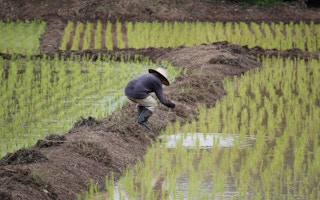More than 2 million hectares of carbon-rich peatlands in Indonesia are still degraded due to recurrent fires in 2015 and 2019 that accounted for an estimated USD $20 billion of human and environmental damage. Peatland restoration is still under progress to aid in restraining fire spread, reducing greenhouse gas emissions, and mitigating climate change.
While the progress of peatland restoration is still not promising, the government of Indonesia is planning to convert 900,000 hectares peatlands to rice fields in the name of food security as the Covid-19 pandemic threatens to cause food shortages across the country.
This plan may repeat an epic past failure in the Mega Rice Project (MRP) in the 1990s. The project failed because government planners had vastly overestimated the extent to which small farmers could manage complex peat ecosystems and handle the commercial scheme.
The MRP produced almost no rice and led to massive peat fires in 1997. Now, some areas that were designated for the project are abandoned wasteland of drained and degraded peat that has since seen a number of fires during the annual dry season.
Nazir Foead, the head of the Peatland Restoration Agency (BRG) said that there won’t be a repeat of the MRP fiasco because the government has learned from its mistakes. He argued that knowledge on how to sustainably manage peatlands has also evolved in the years since, as have government policies on peat protection.
Yet, to date, significant development is still lacking both in farmers’ capacity and successful commercial schemes that enable sustainable cultivation on peatland. Moreover, the BRG is missing an important piece of information: rice as a dryland species is not supporting peat formation for restoration. Planting dryland species such as rice in peatlands is undermining restoration efforts.
Rice does not support peatland restoration
Rice is not native species to peatland. Although dryland species like rice can thrive on peatlands and can be cultivated in such ecosystems, it thrives only when peatlands are drained and dried.
But plant cultivation with drainage is degrading peatland. Dryland species are usually planted alongside box dams with overflow outlets to keep water levels at least 40 cm below the peatland surface. The species that require drainage to grow will not survive on peatlands that are currently being rewetted by restoration programmes.
Dryland species, including rice and some horticultural crops, cannot restore peat to ideal conditions in the long run due to oxidation or interaction between oxygen and other substances on peatland caused by drops in groundwater levels.
Rice cultivation also has an impact on peat subsidence, resulting in the decline of organic matter quality in peatland. In addition, rice is also not proven to form and restore peats. Instead, the cultivation of dryland species on peatland increases the risk of fires and is thus not sustainable and not recommended on ideal peatland hydrology or rewetted peatlands.
In an effective restoration practice, peatland rewetting before planting is important to ensure the plants native to peat swamp can thrive. In wet or rewetted conditions, low levels of biological decomposition facilitate the accumulation of peat. The biological decomposition in wet peats is low for various reasons, including low pH, low oxygen levels, and high polyphenol concentrations.
But these characteristics are different in dry peatland, and the 900,000 hectares peatlands planned for rice fields in Indonesia are mostly dry peatland. Not only will Indonesia’s rice cultivation plans fail to restore peatland, but it threatens these ecosystems as it increases the risk of fires.
What should Indonesia do instead?
To create economic benefits and enable peatland restoration while securing a stable income for rural communities and securing food supply, the government should apply sustainable practices in the concept of paludiculture that involves plant cultivation in wet conditions. Through paludiculture, degraded peatland can be restored and utilised for economic activities.
But currently, an in-depth understanding of the science of paludiculture and its principles is still lacking in Indonesia. The concept of paludiculture was often perceived as a purely revegetation approach to restoring degraded peatlands. This issue sometimes resulted in errors in selecting the vegetation and species to be planted, which undermined peatland restoration efforts.
Stakeholders of peat restoration must base their restoration plans on the latest scientific understanding that dryland species such as rice cannot maintain a peat body and is not proven to provide economic benefits and to help overcome food shortages.
According to the paludiculture concept, two types of plants can grow on peatlands, without the need for drainage: species native to peat swamps and non-native species that adapt to wet peatlands. These species have been proven to produce biomass, to form and restore peats, and to provide economic benefits.
A recent study sheds light on paludiculture. It provides information on native peat swamp species in Indonesia that can support restoration. These species can adapt to acidic soils and are resistant to inundation. Some of them are sago, bitter melon, and water spinach. In total, 165 paludiculture species have a known use for food, while 81 species could supply raw materials for energy, construction, and biochemical products.
Will Indonesia use the knowledge available on farming practices that align with its peatland restoration goals?
Ibnu Budiman is a PhD candidate at Wageningen University in the Netherlands and a consultant in the fields of environmental management and sustainable development.


















